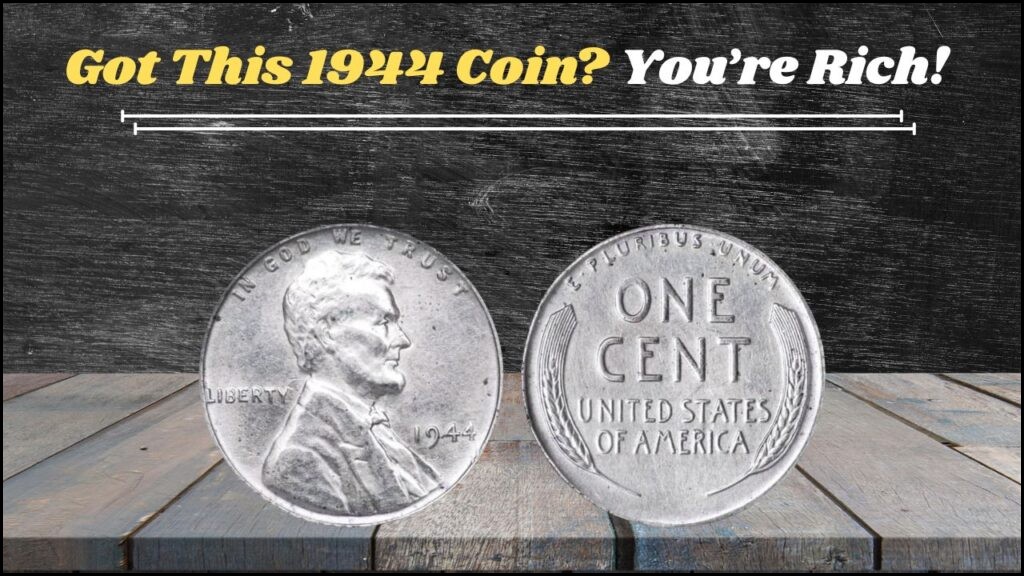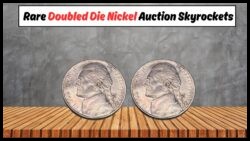1944 Steel Wheat Penny – In the fascinating world of rare coins, few finds are as thrilling or valuable as the 1944 steel wheat penny. Recently, one such coin stunned collectors by selling for a jaw-dropping $180,000 at auction. While many may assume all pennies from the 1940s are common and low in value, the truth is that certain errors and anomalies—like the 1944 steel cent—can turn ordinary pocket change into a small fortune. But what exactly makes this penny so special? Why do only a handful exist? And how can collectors identify a genuine piece from a fake? In this article, we’ll take a deep dive into the story behind the 1944 steel wheat penny, including its history, error origins, value factors, and tips on spotting a real one. Whether you’re a seasoned numismatist or someone who just loves stories about hidden treasure, this guide will open your eyes to the unexpected value hidden in your coin jar.
The Accidental Creation of the 1944 Steel Penny
The 1944 steel penny wasn’t meant to exist. Its very presence is a product of wartime urgency and minting confusion.
Why Was the Steel Penny Created?
During World War II, copper was a critical resource used in making ammunition and equipment. To conserve this metal, the U.S. Mint decided to mint pennies in steel coated with zinc in 1943.
However, by 1944, the mint reverted back to using copper. Despite this shift, a small number of leftover steel planchets from 1943 accidentally found their way into the minting process in 1944.
How Rare Is the 1944 Steel Penny?
The 1944 steel cent is incredibly rare due to its accidental nature. Here’s an overview of known estimates:
| Year | Material Used | Known Surviving Specimens | Mint Locations | Value Range |
|---|---|---|---|---|
| 1944 | Steel (error) | Fewer than 40 | P, D, S | $75,000 – $180,000 |
| 1944 | Copper (regular) | Billions | P, D, S | $0.05 – $2 |
Most collectors will never come across one in their lifetime.
How to Identify a Genuine 1944 Steel Penny
Because of its immense value, the 1944 steel cent has been heavily counterfeited or misrepresented by zinc-coated fakes.
Simple Identification Tips:
- Magnet Test: A genuine steel penny will stick to a magnet, unlike a copper one.
- Weight: Real steel cents weigh around 2.7 grams, compared to 3.1 grams for copper.
- Color: A steel penny appears silver-gray, whereas regular 1944 cents are brown or reddish.
- Date Font and Details: Look closely at the “1944” digits—authentic steel cents have the same design as other wheat pennies of the era.
Trusted Authentication:
| Method | Description | Recommended For |
|---|---|---|
| Third-Party Grading (PCGS, NGC) | Certified professionals will test and encapsulate the coin | High-value or auction-bound coins |
| Spectrographic Analysis | Determines metal composition | Rare coin verification |
| Dealer Expertise | Get a second opinion from a respected coin dealer | Quick initial verification |
Why One Just Sold for $180,000
The specific coin that sold for $180,000 had exceptional qualities—beyond just being rare.
Key Factors in the Record-Breaking Sale:
- High Grade: It was graded MS66 by PCGS, meaning it was nearly flawless.
- Auction Visibility: It was part of a major auction event, increasing collector competition.
- Historical Value: Being one of just a few known examples skyrocketed its desirability.
- Mint Mark: It was from the Denver Mint (1944-D), which is rarer than the Philadelphia version.
Auction Details Table:
| Coin Type | Grade | Mint Mark | Auction House | Sold Price |
|---|---|---|---|---|
| 1944-D Steel Cent | MS66 | D | Heritage Auctions | $180,000 |
Such sales spark excitement across the coin community and renew interest in rare U.S. coin errors.
Where to Look for Hidden Steel Cents
Yes, it’s possible you could find one in circulation—though unlikely. These pennies are more often discovered in old collections or estate coin jars.
Tips for Finding a Steel 1944 Penny:
- Search old wheat penny collections (1950s or earlier).
- Check family coin jars passed down from grandparents.
- Scan eBay and estate sales, but watch for scams.
- Use a magnet and scale for quick screening.
- Buy a 1943 steel penny to compare for practice.
Even if you don’t find one, other rare coins may be hiding in plain sight.
The Investment Potential of Rare Error Coins
The 1944 steel penny is not just a collector’s gem—it’s a serious investment asset.
Why Error Coins Like This Are Valuable:
- Scarcity: Limited mintage or error production makes them hard to find.
- Demand: Collectors worldwide seek U.S. coin errors.
- Storytelling: Unique backstories make coins more desirable.
- Condition and Rarity: A rare coin in high grade sees exponential value.
Error Coin Investment Table:
| Coin Error Type | Value Potential | Notable Example |
|---|---|---|
| Wrong Planchet | High | 1944 Steel Cent |
| Double Die | Medium to High | 1955 Lincoln Cent |
| Off-Center Strike | Medium | Various U.S. coins |
If you have a potentially valuable coin, getting it graded by PCGS or NGC can help maximize your return.
The 1944 steel wheat penny stands as one of the rarest and most thrilling U.S. coin errors of all time. With just a few dozen confirmed to exist, their value will likely continue to grow as collectors compete to own one of these minting miracles. While finding one in your pocket change is extremely rare, checking old coin collections or inherited stashes could still yield surprising results.
Don’t underestimate the power of a simple coin—it might just be worth six figures.
FAQs – 1944 Steel Wheat Penny
Q1. Why is the 1944 steel penny so rare?
Only a few were accidentally minted using leftover steel blanks from 1943, making them extremely limited.
Q2. How do I know if my 1944 penny is steel?
Use a magnet; steel pennies will stick. Also, check the color—it should be silver-gray.
Q3. What is the highest price a 1944 steel penny has sold for?
One recently sold for $180,000 at auction due to its rarity and condition.
Q4. Can I find a 1944 steel penny in my coin collection?
It’s unlikely, but not impossible—especially in old family coin jars or inherited collections.
Q5. Where should I authenticate a rare penny?
Use trusted grading services like PCGS or NGC for professional certification.






